Every year, we at Kuma are fortunate to have the opportunity to directly source our Guatemalan coffees from Bella Vista Mill.

-- You should see how many bags of coffee this guy can carry at once! --
For us, the process begins each year in early spring, when we touch down in Guatemala City then drive about 40 miles through the hilly landscape to Antigua, a small city where cobblestone streets are lined with mostly single story colorful facades leaving only old and beautiful churches towering above. Beyond the tops of churches, are the lush mountains with their rich volcanic soil, supporting coffee farms as far as the eye can see. Antigua is flanked on either side by Volcan de Agua and Volcan de Fuego (volcanoes, water and fire) whose smoke plumes sometimes rise beyond the clouds.
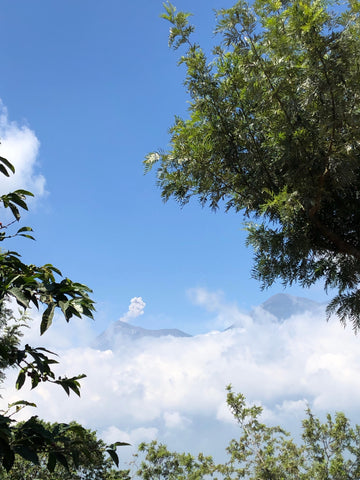
-- View from Melanie's Farm amongst Hunapu microlots--

It is at the edge of the beautiful city of Antigua, that the team at Bella Vista Mill is hard at work processing coffee cherries from 40 farms and over 500 small producers. The entire process is closely monitored to ensure highest quality. Coffees are then diligently cupped for further quality control. The mill is currently operated by Luis Pedro Zelaya Zemora, a fourth generation coffee producer, with the help of Melanie Herrera who keeps the whole operation going, while growing her own coffee. The hard work and dedication of these two and their team shows. Just this year, a new wet mill was built with high end technology to sort and weigh cherries. This also opened up more space for naturally processed coffees and experimentation with various honey processes.
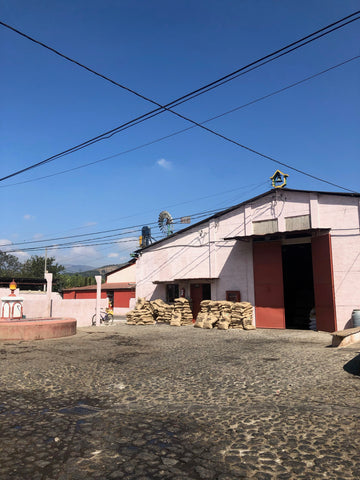
-- Entrance to Bella Vista Mill with the new wet mill to the right --
Bella Vista processes coffees not just from Antigua but from all growing regions of Guatemala, including Huehuetenango and Concepción. Most of the coffees are washed. After fermentation, washed coffees are then patio dried or dried on raised beds for 10-12 days. Coffees that are patio dried are raked during every hour of sun exposure. The temperature of the drying beans are also taken hourly to ensure beans are dried evenly and properly. The staff at Bella Vista does such a good job of this that when we measure moisture content at our roastery when our coffees arrive, we rarely notice great differences between lots. Water used in the washing process is recycled to water avocado trees and cascara and parchment are used as fertilizer. Natural coffees are laid out on patios and dried for about 15 days. Once the hard work of processing is complete, and sample roasting done, our fun begins.
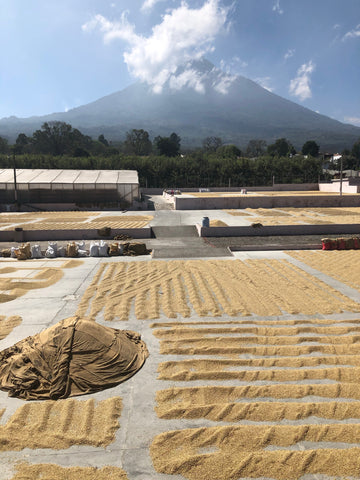
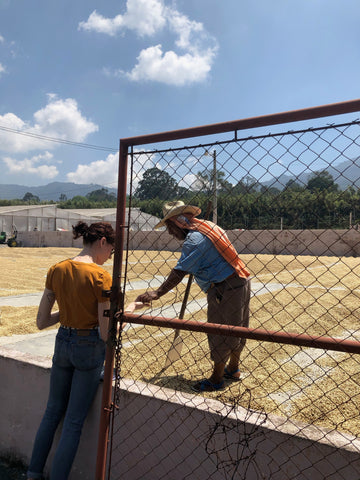
-- Beautiful view of coffee being patio dried and me (Zoe, the roaster) practicing my Spanish with the gentleman in-charge of perfectly drying these beans. He kindly shared with me how much this work means to him --
Alongside the staff at Bella Vista, including one of the best cuppers in the world, thank you Dulce Barrera for sharing your knowledge, we blind taste all the beautiful coffees Guatemala has to offer. Coffees are always cupped blind but often grouped by growing region or farm, highlighting the wide array of profiles the country has to offer. As we taste, we individually score each cup and then discuss flavor notes and other qualities inherent to the coffee. At Kuma, we only purchase coffees we score above an 86; we want to make sure we are getting the best of the best! Along with how a coffee tastes, we look at green beans and moisture content to ensure beans will hold up during shipping and storage and then ultimately, to you all! As we continue to fill our container with vibrant coffees to be shipped to our roastery, we sometimes choose small producer lots that we love. These microlots could grow delicious coffees but yield on a few bags of beans. When we come across a coffee like this, one we are wild about, we may choose another delightful offering on the table that has similar characteristics or would pair nicely and request them to be blended. Just because a lot is smaller does not mean it is less desirable! Blending lots is just one way we like to find exquisite coffees, support smaller scale farmers and make sure there is enough to go around to all our customers!
 -- Just one of many cupping tables, boy did we get caffeinated! --
-- Just one of many cupping tables, boy did we get caffeinated! --
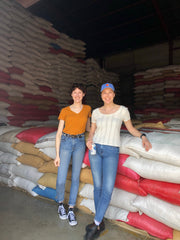

-- A very caffeinated Cecelia (our production manager) and I exploring the mill between cuppings. Look at all the coffee there is to try! --
Although we may cup over 100 coffees in a day, time at the mill is never boring. Between cuppings, we at the roastery are lucky enough to visit the farms around Antigua to learn more about the coffee farms and growing practices. Steep drives to higher elevations highlight the beauty of the landscape, offer expansive views of Antigua below and show just how difficult cultivating and harvesting coffee can be. The coffees in Antigua are grown with great care and often without pesticides. Although choosing natural methods for pest control may take more time and labor, farmers believe the finished product is worth it. All the extra time and attention paid to every step of the process is evident in the quality of every cup.
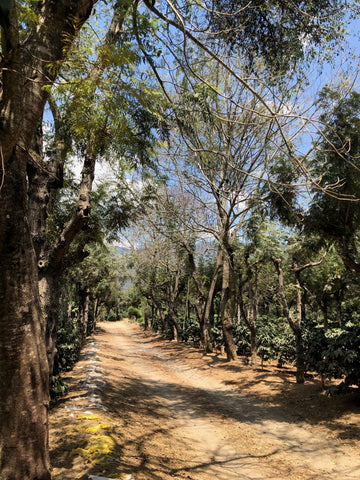 -- The entrance to La Folie, a 40 hectare farm just outside of Antigua --
-- The entrance to La Folie, a 40 hectare farm just outside of Antigua --
Due to drier conditions during this most recent growing season, many cherries were still ripening on the shrubs when we arrived. The hillsides around Antigua are incredibly steep and lack irrigation systems, often too expensive to install. Many plants that were not ripening later than normal, were seriously struggling or dying from lack of water. Although the Guatemalan coffees we will see coming in this summer may be denser and possibly sweeter due to longer growing time, developing more sugars and a more compact cell structure, the struggling coffee shrubs are a strong reminder that we all need to do our part to try and manage the effects of climate change. As many as 200 million people around the world rely on the health and success of a coffee crop for their livelihood. The farmers we got to meet in Antigua, and those all over the world, are incredibly passionate about their crops and caring for the land. Care must be taken by all to support the hard word of coffee farmers and ensure access to delicious brews for generations to come.
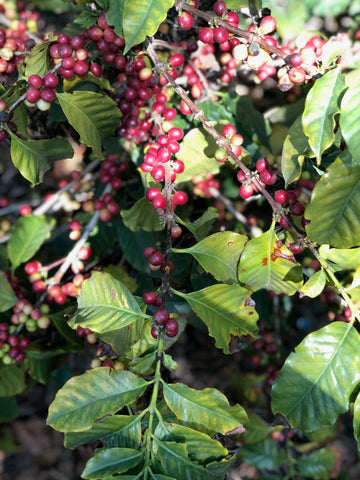 -- A healthy coffee shrub. Everyone at the farms were so kind and eager to teach us all about identifying varietals and what makes each one unique. You can even taste the cherries for more clues! --
-- A healthy coffee shrub. Everyone at the farms were so kind and eager to teach us all about identifying varietals and what makes each one unique. You can even taste the cherries for more clues! --
We at Kuma are eagerly awaiting the arrival of our Guatemalan coffees! We look forward to roasting them with care, drinking these vibrant cups again and sharing them with you all.
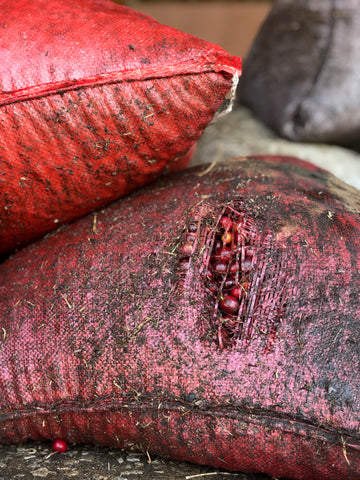
-- Fresh arrival of cherries waiting to be processed --
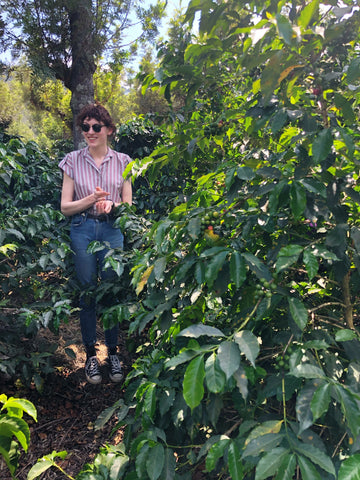
-- I will be looking forward to visiting Guatemala again. But in the mean time I will have to improve my coffee cherry picking speed. Not impressive. --
-- Zoe, Roaster for Kuma Coffee, 4/16/2020
*For more information about Bella Vista Mill, check out their website:
http://www.bellavistacoffee.com
